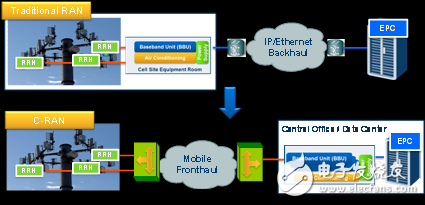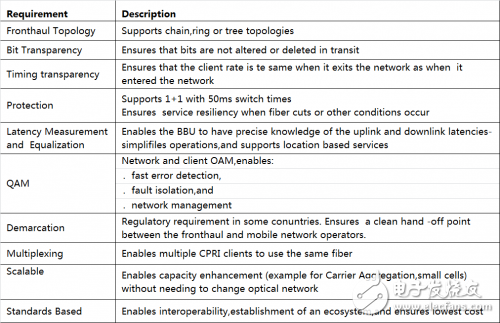Mobile operators around the world are investigating new architectures for wireless access networks to reduce costs through infrastructure updates while increasing network capacity. The Cloud Wireless Access Network (C-RAN) architecture is the leading solution to this challenge. But C-RAN also brings a new problem: how to solve the problem of the extended interface between the radio head (RRH) and the baseband unit (BBU)? The industry calls this front-end backhaul. Among all possible solutions, the OTN-based mobile front-end backhaul solution best meets the performance goals and technical requirements pursued by mobile operators, but there is still a lack of available solutions on the market. PMC-Sierra introduces support for mobile front-end backhaul in its HyPHY family of OTN processors, offering a range of innovative features that can be easily enabled by updating software and firmware.
About the AuthorScott Wakelin is a Senior Product Manager in the Communications Business Unit at PMC-Sierra, where he is responsible for OTN and mobile front-end backhaul solutions and strategies. Mr. Wakelin has 14 years of experience in the networking industry and continues to develop innovative semiconductor solutions. Mr. Wakelin graduated from the University of Washington with a master's degree in applied science and studied marketing at Foster Business School.
1. Challenge: C-RAN comes to the forefrontChina's mobile communications market is experiencing an amazing growth. China's market is calculated by the number of users (up to 1.2 billion at the end of 2013), and it has already ranked first in the world. The industry is working for the next round of battle: 4G is accumulating strength, and China Mobile has already taken advantage of this advantage in this vital new market. By the end of 2014, 720K TD-LTE base stations have been deployed, but they are still facing increasing Urgent competition. At the end of February 2015, the Ministry of Industry and Information Technology of China officially issued FD-LTE business licenses to China Telecom and China Unicom. With the license, the three major operators will deploy between 200,000 and 300,000 new 4G base stations in 2015 alone – leading the global mobile infrastructure market.
Such incredible new infrastructure growth is due to the need to remain competitive, and on the other hand, the growing demand for mobile data and video for mobile phone users. According to data from Cisco's VNI, China Mobile's network users are expected to increase mobile traffic by 15 times between 2013 and 2018 - one of the highest growth rates in the world. Just look at the latest annual report released by China's mobile operators to understand why the forecast may come true. China Mobile, which deployed 720,000 TD-LTE base stations, won 90 million 4G subscribers in 2014. These 4G users plus existing 3G users have led to an annual growth rate of mobile data on the CMCC network of 115%. At the same time, China Mobile's ARPU fell by 9%. Similar characteristics can be observed from the core performance indicators of China Telecom and China Unicom.
Taken together, these factors are clearly in a dilemma – having to look for new ways to provide more capacity at a lower unit cost. This challenge has led mobile operators to consider rebuilding new architectures for the Radio Access Network (RAN) to address their pain points in terms of capacity, CapEx and OpEx.
C-RAN has become the most watched new architecture. In the C-RAN architecture, mobile baseband processing equipment (and associated air conditioning and power equipment) migrated out of the base station and moved into a nearby office or data center. See Figure 1.

Figure 1 C-RAN architecture
1.1 By centralizing baseband processing
Network operators are expected to increase capacity and reduce costs by reducing base station operating costs and reducing baseband total deployment capacity through baseband pooling. However, C-RAN also brings a new challenge to the network: front-end backhaul.
Today, most mobile networks are built around a distributed architecture, with each site equipped with a baseband processing (BBU), air conditioning, and power supply equipment room. Each partition of the antenna on the base station tower is connected to a remote radio head (RRH), which in turn is connected to the BBU via a fiber-based general public radio interface (CPRI). Most base stations currently have three partitions, each corresponding to a single 20 MHz carrier. In the C-RAN model, CPRIs sent from each RRH may transmit up to 20 kilometers to a centralized point equipped with baseband equipment.
For optical equipment manufacturers, front-end backhaul networks mean a major new market opportunity. Driven by the challenges and opportunities brought by the front-end backhaul, China's mobile operators and core technology companies such as PMC-Sierra presented their views at the China Communications Standards Association (CCSA) meeting in October 2014. The report highlights the unique situation, needs of the operators and the solutions that have been explored so far.
Now, turn your attention to the needs of carrier-grade front-end backhaul networks.
1.2 Front-end backhaul network requirements
The most basic requirement for front-end backhaul is to support the CPRI client rate. China's CPRI rate is determined by whether the operator deploys TD-LTE or FD-LTE. With the new FD-LTE license, CPRI opTIon 3 (2.5G) and future CPRI opTIon 5 (4.9G) will dominate the mobile network of China Telecom and China Unicom. In contrast, China Mobile, which already has 720,000 TD-LTE base stations, uses CPRI opTIon 7 (9.8G).
In addition to the CPRI rate requirements, the strict timing and delay requirements imposed by CPRI and its 3GPP in terms of time and frequency need to be met.
Since the RRH generates a clock signal based on the received CPRI signal, the jitter of the CPRI signal needs to be as small as possible. The upper limit of jitter set on the CPR specification is 2 ppb. More importantly, in order to ensure that the 3GPP HARQ goal can be achieved, the front-end backhaul network must support a round-trip two-way delay of less than 400 μs, which means that the end-to-end delay should be controlled within the range of 150-200 μs.
A often overlooked requirement is that the uplink and downlink delays are almost completely symmetric. Although each mobile device has a different number for this, the general requirement is < +/- 65 ns.
There are also a number of specific application and operational layer requirements for front-end backhaul, as shown in Table 1. Meeting the sum of these requirements can achieve a deployable, low-cost carrier-grade front-end backhaul network—an ENT that is indispensable.

Table 1 Requirements for front-end backhaul at the application and operation level
All these requirements make operators consider the following options when considering front-end backhaul networks: point-to-point fiber, microwave, passive WDM, active WDM and OTN.
Although OTN undoubtedly has operational advantages in many aspects such as OAM, demarcation and scalability, the industry still has a tendency to meet the performance requirements of OTN, which leads to the industry still prefer to use active or passive WDM. The solution is to perform front-end backhaul. This is due to the proliferation of a large number of vendors offering a variety of passive or active WDM solutions, but the lack of available OTN-based solutions on the market.
Recently, through a solution based on its HyPHYflex OTN processor, PMC has proven that OTN can meet the performance requirements of mobile networks, thus opening a new era of true carrier-class front-end backhaul networks.
In the following sections, we will continue to explore and explain why the OTN-based mobile front-end backhaul solution best fits the unique environment of China's mobile operators.
Earlier we analyzed the operator's need for front-end backhaul networks. The four major candidate technologies for implementing front-end backhaul networks are discussed below.
Point-to-point fiber
Passive WDM
Active WDM
OTN
2.1 point to point fiber
In a front-end backhaul network implemented by point-to-point fiber, each remote radio head (RRH) at the base station is connected to the BBU through a single fiber or fiber pair. This is the simplest of all front-end backhaul solutions, and the rich fiber resources deployed by Chinese mobile operators (especially China Unicom and China Telecom) make it easy to deploy, and there is no need for this solution. The front end returns the network device.
However, since at present three base stations require at least three CPRIs for LTE, and at most 15 CPRIs may be required for 5x telecom aggregation in the future, the point-to-point fiber solution is not practical, and is implemented in large-scale C-RAN deployments. Not economical.
As a result, mobile network operators are always looking for an optimized solution to take advantage of their valuable fiber resources.
2.2 Passive WDM
Passive WDM is the first choice. In a passive WDM-based front-end backhaul solution, CWDM or DWDM optical modules are directly installed on the RRH and BBU, and a passive optical add/drop multiplexer (OADM) is used to multiplex multiple wavelengths onto a single optical fiber. , where each wavelength carries a CPRI connection. In a CWDM system, up to 18 wavelengths can be carried on a single fiber.
Although the WDM-based front-end backhaul system has a significantly higher fiber utilization than the point-to-point solution, each CPRI signal still consumes a 10G wavelength regardless of the CPRI rate. Further, the passive WDM solution does not provide a demarcation point or fault isolation between the mobile RAN and the front-end backhaul network, and its management and fault isolation function (OAM) is very primitive.
2.3 Active WDM
The active WDM scheme uses a separate muxponder outside the OADM to place the CPRI signal above a certain bandwidth. The main advantage of an active WDM solution over a passive WDM solution is its ability to act as a demarcation point and provide limited fault isolation. However, like passive WDM, each CPRI signal consumes a bandwidth. The OAM function is quite limited and inherently proprietary (non-universal). The operation and maintenance team of the telecommunication network is also quite strange.
Shenzhen Aierbaita Technology Co., Ltd. , https://www.aierbaitavape.com